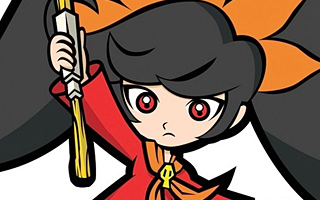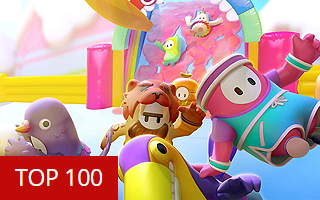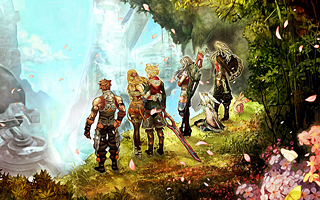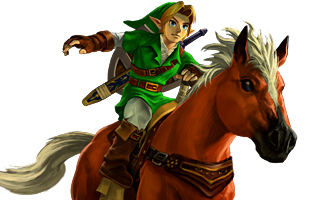Atari 8-bit Family
Top 10 Best Atari 8-bit Games of All Time!
Although Atari is more closely associated with video game consoles, their 8-bit line of computers was on the market for over a decade. Atari’s 8-bit computers were initially intended to serve as a replacement for the newly-minted Atari 2600. As the first home computers designed with custom co-processor chips, Atari’s machines were able to offer graphics and sound capabilities beyond what contemporary computers like the Apple II could produce. In some ways, Atari’s computers felt like glorified gaming consoles. They used ROM cartridges instead of tapes or discs, their operating systems would boot automatically, and they supported an array of plug-n-play peripherals. They were widely available in department stores, while many of their competitors were still being sold exclusively by computer retailers. Many of the games released for Atari’s 8-bit computers were also released on the Atari 2600 or Atari 5200, but there were a handful of killer apps that weren’t given a console release.
10
Rescue on Fractalus!
1985

Rescue on Fractalus! tasks players with piloting a space fighter through cavernous terrain in an effort to locate visual beacons and rescue stranded pilots. Along the way, players will have to manage their fuel supplies, avoid anti-craft gun turrets, and take on kamikaze flying saucers. A certain amount of strategy is required to be successful in the rescue attempts. For example, if players become impatient and attempt to ignite their engines too early, they might inadvertently incinerate the very pilot they were attempting to rescue. Complicating things further is the fact that some of the downed pilots are actually aliens in disguise! (Reportedly, this facet of the game was included at the request of George Lucas himself.) Rescue on Fractalus! is played from a first-person view and was notable for its innovative use of pseudo-3D graphics. Today, the game is probably best remembered for the hostile aliens that would viciously pound on the ship’s windshield in a thinly-veiled attempt to traumatize little kids.
9
Donkey Kong
1983

Donkey Kong was notable for a number of reasons. It introduced the world to Donkey Kong and Mario, it was the first game designed by Shigeru Miyamoto, and it popularized the concept of a jump button. It was also notable because it had four unique stages to play through. The first stage challenged players to jump over rolling barrels, the second stage involved moving elevators, and the goal in the fourth stage was to destroy a construction site by walking over rivets. The reason why I skipped over the third stage is because almost everyone else did too! All of the console ports from the ’80s (and many of the home computer versions) omitted the conveyor belt stage from the original arcade game. The level was even missing in Nintendo’s own NES port! The fact that the Atari 8-bit version has all four stages from the arcade is reason enough to describe it as one of the best classic ports of the game. Atarisoft gave us the first home version to feature all four levels, so I felt compelled to include Donkey Kong on this list out of principle.
8
Missile Command
1982

The goal in Missile Command is to protect the planet from a relentless hail of ballistic missiles. This is done by moving a cross-hair around the screen and carefully launching counter-missiles. It’s essential for players to accurately gauge the trajectory of the attack missiles and time their counter-attacks accordingly. The 5200 version is blockier than the original arcade game, and there is only one base to attack from instead of three. These complaints are pretty minor in the grand scheme of things though, as the gameplay holds up pretty well. Missile Command was perhaps best-known for its implementation of trackball controls, and the Atari 8-bit version fully supports this control method. This feature is greatly appreciated, especially since the 2600 version of Missile Command didn’t work very well with the trackball controller and many console ports didn’t support a trackball in any capacity. Missile Command played an important role in Atari’s 8-bit library and was included as a built-in game for the Atari XEGS.
7
Frogger
1983

I was first introduced to Frogger on a portable tabletop version released by Coleco. The game had a tiny joystick and a three-inch screen, but it was incredibly addictive and surprisingly playable. I’ve played dozens of Frogger ports over the years, and most of them have been pretty good. The Atari 8-bit version is more colorful than many other ports from the era, but Frogger is fun regardless of what format you play it on. The premise of the game involves a group of frogs who are desperate to make their way home. The action takes place on a single screen, and players are required to cross busy highways and a flowing river by dodging traffic, hopping on logs, and catching rides on the backs of turtles. You’ll also have to be mindful of deadly snakes and hungry crocodiles. The Atari 8-bit also had a stellar port of Frogger II: ThreeeDeep, but I’ve always preferred the simplicity of the original game over the three-screen format adopted by the sequel.
6
Joust
1983

In Joust, players take to the skies on the back of a flying ostrich and attempt to knock their rival jousters to the ground. The game was first released in arcades in 1982 and helped pave the way for every momentum-based platformer that followed. It was also one of the first games to feature a multiplayer component that was both cooperative and competitive at the same time. The influence of Joust can be seen in games like Mario Bros. and Balloon Fight from Nintendo. (Balloon Fight is basically a Joust clone.) Joust was ported to virtually every system on the market, and the Atari 8-bit version was among the best. The graphics weren’t quite as detailed as they were in the arcades, but the sprites are well-animated and the gameplay is spot on. The Atari 7800 port is generally considered to be superior, but there was still a four-year period where the Atari 8-bit version reigned supreme among all home ports.
5
Millipede
1984

With Centipede, Atari took an interesting approach to the shoot ’em up genre by setting the game in a garden instead of outer space. Using a trackball, players would move along the bottom of the screen while clearing out mushrooms and blasting away at harmful centipedes, spiders, scorpions and fleas. The game was a smashing success and was one of the first games to attract a significant female audience. Millipede followed the same formula, but added several additional types of insects and introduced stationary DDT bombs that could take out multiple enemies at once. I’ve seen Millipede described as “Centipede on steroids, but that analogy doesn’t make a lot of sense. After all, Millipede isn’t stronger, it doesn’t get irrationally angry, and it isn’t any more likely to contract kidney disease. It’s probably a better game than Centipede, however, even if it doesn’t get the same attention in the gaming world. Millipede was somewhat less successful than its predecessor and was only ported to a handful of platforms. The Atari 8-bit version looked considerably nicer than its Atari 2600 counterpart, it controlled better than the NES version since it supported a trackball controller, and it did a much better job of actually existing than the unreleased Atari 5200 prototype.
4
Pitfall II: Lost Caverns
1984

Pitfall II was arguably the most technically impressive game ever released on the Atari 2600. The game’s cartridge even contained extra hardware to allow it to do things that would otherwise be impossible on the console, similar to Nintendo’s Super FX Chip. Graphical effects like moving waves were amazing for the 2600, but they simply weren’t as notable on Atari’s line of 8-bit computers. Even with the “wow factor” removed, Pitfall II is still a great game. The innovative checkpoint system allowed for a much longer adventure than most games offered. Most games of the era were broken up into completely separate levels, but Pitfall II is comprised of one large area with many checkpoints placed along the way. In the days before passwords or battery backups had become common place, this concept felt pretty revolutionary. The Atari 8-bit version of Pitfall II doesn’t look significantly better than the 2600 version, but it’s a much better game by virtue of the fact that it’s considerably longer. The game was known as the Adventurer’s Edition and presented players with a brand new area to explore after they found the necessary treasures to “complete” the game. The enemies are more aggressive and less predictable in the new area, and more emphasis is placed on platforming. The Atari 5200 also featured the extra Adventurer’s Edition content, but the Atari 8-bit version stands as the definitive version mostly because the Atari 5200’s controller was a complete disaster.
3
Dropzone
1984

Dropzone is a side-scrolling shoot ’em up that tasks players with patrolling a lunar surface to rescue research scientists from invading alien forces. The player wears a jetpack and is is armed with a laser, a cloaking device, and three smart bombs. Players can move either left or right, and a useful radar at the bottom of the screen shows the location of their enemies and the distressed scientists. It this doesn’t remind you of Defender yet, the font used on the title screen probably will. It’s easy to see where Dropzone got its inspiration from, but it’s vastly superior to any home port of Defender. Besides, flying around with a jetpack is more fun than flying a boring spaceship. Dropzone was designed for the Atari 8-bit family and was later released on a number of other home computers. The game’s creator described Atari as “the Porsche of home computers” and praised the performance of the Atari 8-bit version compared to subsequent ports.
2
Bounty Bob Strikes Back!
1984

Bounty Bob Strikes Back! is a single-screen platform game and the sequel to Miner 2049er. Like its predecessor, the object is to venture into an abandoned mine in search of a fugitive. Players are required to investigate every inch of scaffolding in the mines, but various radioactive creatures make this a difficult task. The mines are filled with mazes of chutes and ladders, and a host of futuristic devices like transporters and hydraulic scaffolds are also present. With 25 stages to play through, Bounty Bob Strikes Back! is over twice as large as Miner 2049er and a lot more challenging. The gameplay is a little more forgiving, however, and the player’s progress is no longer reset after they lose a life. Miner 2049er was one of the most critically acclaimed games of the early 1980s. Versions of the game were released on nearly two dozen systems, and it was named “Game of the Year” by Electronic Games in 1983. The sequel didn’t get as much attention in the press and was only released on a handful of systems, but it’s a hidden gem and one of the best platform games of its era.
1
M.U.L.E.
1983

This might sound like hyperbole, but M.U.L.E. is one of the most creative games ever devised. It’s hard to explain, but it’s basically a multiplayer strategy game based around supply and demand economics. The purpose of the game is for players to compete against each other in order to obtain resources and amass wealth. Central to the game are the eponymous “M.U.L.E.”s (Multiple Use Labor Element), which are used to harvest and develop resources. Players will use these M.U.L.E.s to harvest energy, food, and minerals. Each item has it’s own benefits. Materials are needed for creation of new M.U.L.E.s, while having a shortage of food will result in the player having a shorter turn. The key to the game is controlling the supply and demand of resources by using what you need and selling what you don’t at the highest possible price. Like in real life, players are encouraged to exploit (or create) shortages in an effort to artificially drive up prices. The game also rewards players for colluding with others to manipulate the market. An element of randomness is added to the game as a means of keeping the playing field even. Players will have to deal with run-away M.U.L.E.s, thieving space pirates, sunspot activity, and meteorites. Unfavorable events never happen to the player in last place, so the game remains competitive throughout. A game based around economics might sound boring, but M.U.L.E. allowed four people to play at the same time and was one of the earliest examples of a party game.





Do you agree with this list? Let us know what you think by leaving a comment below. Your opinion matters!